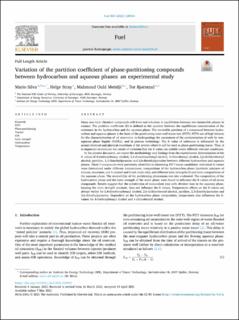| dc.identifier.citation | Silva, M., Stray, H., Metidji, M. O., & Bjørnstad, T. (2021). Variation of the partition coefficient of phase-partitioning compounds between hydrocarbon and aqueous phases: an experimental study. Fuel, 300, 120915. | en_US |
| dc.description.abstract | Many non-ionic chemical compounds will form real solutions in equilibrium between two immiscible phases in contact. The partition coefficient (K) is defined as the quotient between the equilibrium concentration of the substance in the hydrocarbon and the aqueous phase. The reversible partition of a compound between hydrocarbon and aqueous phases is the basis of the partitioning inter-well tracer test (PITT). PITTs are of high interest for the characterization of oil reservoirs, in hydrogeology for assessment of the contamination of soils by non-aqueous phase liquids (NAPLs), and in process technology. The K value of substance is influenced by the actual chemical and physical conditions of the system where it will be used as phase-partitioning tracer. Thus, it is important to evaluate the extent of variation that the K value can exhibit under different relevant conditions.
In the present document, we report the methodology and findings from the experimental determination of the K values of 4-methoxybenzyl alcohol, 3,4-dimethoxybenzyl alcohol, 4-chlorobenzyl alcohol, 2,6-dichlorobenzyl alcohol, pyridine, 2,3-dimethylpyrazine and 2,6-dimethylpyrazine between different hydrocarbon and aqueous phases. These 7 compounds were previously identified as interesting PITT tracer candidates. Individual K-values were determined under different temperatures, compositions of the hydrocarbon phase (synthetic mixtures of toluene, isooctane, and 1-octanol and 5 real crude oils), and different ionic strengths (I) and ionic compositions of the aqueous phase. The reversibility of the partitioning phenomena was also evaluated. The composition of the hydrocarbon phase and the ionic strength of the water phase were found to influence the K values of all seven compounds. Results suggest that the substitution of monovalent ions with divalent ions in the aqueous phase, keeping the ionic strength constant, does not influence the K values. Temperature effects on the K-values are always visible for 3,4-dimethoxybenzyl alcohol, 2,6-dichlorobenzyl alcohol, pyridine, 2,3-dimethylpyrazine and 2,6-dimethylpyrazine. Dependent on the hydrocarbon phase composition, temperature also influences the K-values for 4-methoxybenzyl alcohol and 4-chlorobenzyl alcohol. | en_US |

